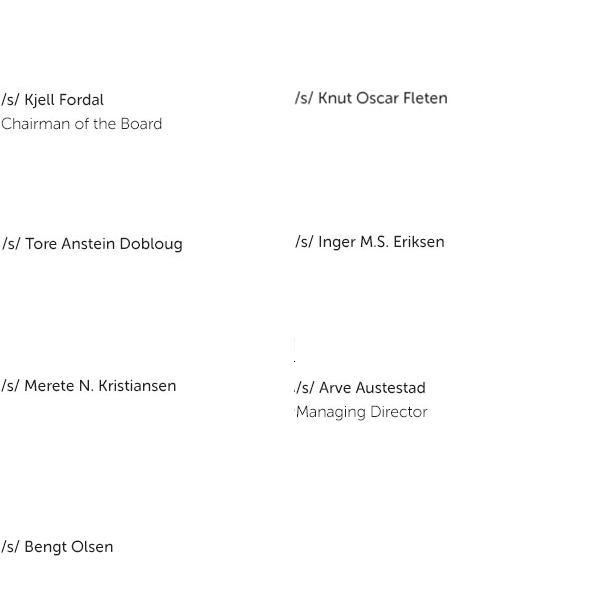Boligkreditt 3rd Quarterly Report 2020
Statement of the board of directors
SpareBank 1 Boligkreditt’s purpose
SpareBank 1 Boligkreditt AS (‘Boligkreditt’, ‘SpaBol’, or ‘The Company’) is a credit institution licensed by the Norwegian Financial Supervisory Authority (Finanstilsynet) and is operated according to the legislation for covered bond issuers in Norway which is included in the Financial Institutions Act (“Finansforetaksloven”) chapter 11, section II and the detailed regulations thereof.
The purpose of the Company is solely to provide funding for its owner banks by buying qualifying residential mortgage loans from them with a loan-to-value (“LTV”) of up to 75 per cent and financing these through the issuance of covered bonds 1.
The Company, which is based in Stavanger, is owned by banks which are all members of the SpareBank 1 Alliance. A comprehensive agreement with each of these banks regulates the mortgage purchasing process and the obligations which the banks owe the Company and its mortgage customers (“Transfer and Servicing Agreement”). The Company pays out the interest margin earned to its owner banks, with deductions for estimated operating and financial expenses. This margin is accounted for as commissions to owner banks.
The Company’s issuances of covered bonds mainly take place under the EUR 35,000,000,000 Global Medium Term Covered Note Programme (GMTCN Programme). This Programme was updated on April 20, 2020 and is available on the Company's home page: https://spabol.sparebank1.no.
The Company has procured the services of Moody’s Ratings Service to evaluate the credit quality of the issuances under the GMTCN Programme. The covered bonds rating is Aaa.
1 The limit for instalment mortgages is 75 per cent, while mortgages which have no scheduled repayment structure are limited to 60 per cent. All mortgages above 60 per cent must be amortizing by at least 2.5 per cent per year according to current mortgage market regulations.
Cover pool and outstanding covered bonds 2
SpareBank 1 Boligkreditt’s cover pool consists of residential mortgages and liquid, highly rated assets as well as derivatives hedging liabilities in a foreign currency and/or at fixed rates. The chart below illustrates the balances as of the end of the third quarter 2020:
The amount of liquid assets varies over time, and the variation is solely a result of the Issuer’s liquidity risk management (and regulatory requirements), whereby upcoming redemptions are refinanced prior to the maturity of outstanding bonds (minimum 180 days) with bond proceeds invested as liquid assets. Liquid assets are covered bonds with a triple-A rating, SSA or government bonds with a triple-A rating, or short-term cash deposits and repos (please see the cover pool statistical reports for details on the composition of liquid assets).
Derivatives are used solely to hedge currency and interest rate risk. They are tailored to exactly match the cash flows related to the bonds they hedge for the full duration of the bond. Swap counterparties are subject to certain rating criteria and are in all cases banks other than the Company’s owner banks.
The table below provides an overview of the residential mortgages in the cover pool, as well as the overcollateralization.
Residential mortgages key figures
| Q3 2020 | Q2 2020 | Q1 2020 | Q3 2019 | ||
|---|---|---|---|---|---|
| Weighted Average Current LTV (%) | 51.8 % | 52.6 % | 53.2 % | 53.6 % | 52.1 % |
| Weighted Average Original LTV (%) | 59.3 % | 59.4 % | 59.3 % | 59.7 % | 59.6 % |
| Average Loan Balance (NOK) | 1,488,367 | 1,470,921 | 1,456,844 | 1,443,119 | 1,440,088 |
| Number of Mortgages in Pool | 138,275 | 137,427 | 136,884 | 132,358 | 131,564 |
| Pct. of non first-lien mortgages | 0.0 % | 0.0 % | 0.0 % | 0.0 % | 0.0 % |
| Overcollateralization | 4.3 % | 7.2 % | 4.2 % | 4.1 % | 5.9 % |
Key developments during the first three quarters of 2020
SpaBol issued 6.4 billion Norwegian kroner of covered bonds in the domestic market during the first quarter 2020, and additional 5.9 billion kroner in the second quarter.
At the end of May, Boligkreditt issued a new SEK 7.5 billion green covered bond, which was well received amongst Scandinavian based investors. The bond was later, during the 3rd quarter, increased to SEK 8.5 bn. This was followed up with a EUR 1 bn green covered bond with a 7 year maturity in September.
With the market turmoil and worsening economic outlook, the countercyclical capital buffer for banks was reduced on March 13. This buffer requirement, which previously was increased by 0.5 percentage points on December 31, 2019 to 2.5 per cent, was reduced to 1.0 per cent. A reduction in the buffer takes place with immediate effect. However, the systemic buffer is scheduled to increase by 1.5 per cent by December 31, 2020.
The Board of Directors views Boligkreditt as well capitalized with a capital coverage ratio of 24.0 per cent against a total requirement of 15.4 per cent. including all buffers, and a 0.9 per cent. Pillar 2 requirement. Total CET1 capital is 21.4 per cent. against a total requirement, including buffers, of 13.4 per cent. Common equity capital was 19.8 per cent. against a requirement, including all buffers, of 11.9 per cent. It is the Company’s policy to maintain capital ratios slightly above the regulatory requirements. When required, additional common equity is contributed by the owner banks in the regular course of business, usually in connection with increases in transferred mortgage volume. Additional Tier 1 and Tier 2 capital is raised in the Norwegian domestic market.
After the outbreak of the pandemic, Boligkreditt’s mortgage portfolio recorded some increase of mortgage loans with principal payment deferral. Such mortgages increased from 16.9 per cent. at the end of February to 26.1 per cent. at the end of May, but has since returned to 20 per cent. at the end of September. A mortgage loan with a loan to value below 60 per cent, may have an installment free period under normal times, but this was relaxed during the pandemic. The Norwegian unemployment rate, which was the driver for the increase in repayment breaks, increased to above 10 per cent during the spring, but stands at 3.7 per cent at the beginning of October (actual registered unemployment).
The financial accounts for the first three quarters of 2020 were impacted by the market turmoil in the first quarter 2020, with credit spreads widening and the 3-month NIBOR rate falling. With the second quarter, credit spreads decreased, and NIBOR stabilized, leading to an increase in valuations of financial instruments, thus a negative result in the first quarter turned to a positive pre-tax result for the first half and three quarters of 2020.
Quarterly Accounts
The accounts have been prepared in accordance with the International Reporting Standards (IFRS) as adopted by the EU and published by the International Reporting Standards Board (IASB).
The Board views the accounts as presented to be a true representation of SpareBank 1 Boligkreditt’s operations and financial position as of the end of the third quarter 2020. Numbers in brackets refer to the corresponding period last year for comparison.
The total balance sheet at 30.09.20 amounted to 287 (252) billion kroner. The increase is primarily due to an increase in mortgage volume and an increase in the value of derivatives hedging issued debt, as well as collateral received. The Company had in the first three quarters of 2020 net interest income of 1,5 (1,4) billion kroner on higher mortgage volume. Reduced mortgage rates were gradually reflected in lower financing costs through the second quarter. Commissions paid to the owner banks were 1,2 (1,1) billion kroner and represent most of the margin between mortgage interest rates and the Company’s funding costs. The cost of operations for the first three quarters of 2020 was 29 (26) million kroner, including depreciation and amortization. IFRS 9 expected loan losses increased by 11 (-2) million kroner. The loan losses are assessed by applying the IFRS 9 principles and model and taking into account various economic outlooks as weighted scenarios. No actual loan losses have occurred since the Company commenced operations. This produces an operating result of 182 (209) million kroner before tax. Valuation changes in fair value of financial instruments (issued bonds as well as bond investments) was a major contributor to the change in result.
Mortgage loans for residential properties amounted to 206 (190) billion kroner as of the end of the third quarter. The Company’s own liquid assets were approximately 28 (23) billion kroner. Liquid assets are cash and highly rated, highly liquid bonds that are held to meet, at a minimum, 180 days of forward outflows. This liquidity buffer rule is also included in the EU covered bond harmonization directive.
Risk aspects
SpareBank 1 Boligkreditt, as a licensed and regulated covered bond issuer, is subject to strict rules regarding its exposure to credit, market, and liquidity risks. This fact, and the aim of the maintenance of the Moody’s Aaa rating, mean that the Company is subject to low levels of risk and places strong emphasis on risk control.
Credit Risk is defined as the risk that losses can occur as a consequence of that customers and others not having the ability or willingness to meet their obligations to SpareBank 1 Boligkreditt. Because the Company buys residential mortgages within 75% of the value of the objects on which the mortgages are secured, the Board of Directors concludes that the credit risk is lower than that for Norwegian banks in general.
Market risk is defined as the risk of losses due to changes in market rates, i.e. interest rates, exchange rates and the prices of financial instruments. At the end of the accounting period, SpareBank 1 Boligkreditt AS had issued bonds for approximately 157 billion kroner in EUR, 9.3 billion kroner in GBP, and 9.3 billion kroner in SEK, based on exchange rates at September 30, 2020. However, all borrowing and investments with a fixed rate, and all borrowing and investments in foreign currency, have been hedged by financial currency- and/or interest rate swap agreements, or through natural hedges. The collective cash flow from FX amounts hedged with swaps matches borrowing in Norwegian kroner with floating rate conditions (NIBOR 3 months). The Company receives collateral from its counterparties in derivative agreements according to certain criteria.
The bonds held in the Company’s liquidity portfolio are mainly Nordic covered bonds and German supra sovereign and agencies (agencies guaranteed by the German government) with a triple-A rating from Fitch, Moody's or S&P. Deposits are placed in banks with a minimum rating of A/A2. Cash is also placed in reverse repos with approved counterparty banks, with AAA rated securities as collateral.
The Company had as of September 30, 2020 only moderate interest rate risk and currency risk.
Liquidity risk is defined as the risk that the Company is not able to meet its obligations at maturity, or to finance the purchase of loans at normal terms and conditions. Liquidity risk is managed based upon a liquidity strategy approved by the Board of Directors. According to the strategy, SpareBank 1 Boligkreditt AS shall maintain a material liquidity reserve with a minimum size equal to, or more than all debt maturities within the next 6 months. The Board of Directors views SpareBank 1 Boligkreditt AS’s liquidity situation as good.
Operational risk is defined as risk of loss due to error or neglect in transaction execution, weakness in the internal control, or information technology systems breakdowns or malfunction. Reputational, legal, ethical and competency risks are also elements of operational risk. The risk is assessed by the Board of Directors to be moderate.
The Company spends time identifying, measuring, managing and following up on central areas of risk in such a way that this contributes to meeting its strategic goals. The notes 23 to 27 in the 2019 annual accounts provide further information in this respect. .
Macroeconomic development and outlook
The outlook for 2020 changed dramatically due to the Covid-19 crisis, but have since the spring been adjusted upwards (see forecast by Statistics Norway (SSB) in the table below).
The improved 2020 GDP projection of a 3.2 per cent decline, rests on improvement in both the consumption and investment areas, compared to earlier estimates for the year. The recovery is evidenced in unemployment too. The SSB unemployment survey level at 5.2 per cent for the June through August period is forecast at 4.9 per cent for the full year, while registered unemployment was only 3.7 per cent in early October 2020.
Infections have increased this autumn in Norway too, and new infections were above 20 per million for the seven-day rolling average in early October, a level which was last seen in April 2020. This level is the limit for when the Norwegian authorities set travel quarantine restrictions for other countries, which is also now in place for almost all countries. The increased level of infections increases economic uncertainty, but the outbreaks are also limited in geography, hence no general business restrictions loom at the time of writing.
Oil price and oil investments continue to be a slight economic drag in 2020 and more so in 2021. Business investments is the main driver for the negative mainland investment level in 2020, with also 2021 a drag on growth, after recent expansive years. Investments in residential real estate is also lower in 2020, but is expected to contribute to GDP growth in 2021.
Residential house prices, as expressed by the national index stand 5.8 per cent higher in September 2020 compared to a year earlier. Interest rates dropping to record low levels are seen as the main driver for this development, which includes regional differences. The activity level in the real estate market has been robust this year, with a high number of transactions measured on the same year-to-date period for the previous ten years.
| Recent data and forecast (per cent) | 2018 | 2019 | 2020 | 2021 | 2022 |
|---|---|---|---|---|---|
| Mainland GDP growth | 2.2 | 2.3 | -3.2 | 3.6 | 2.9 |
| Private consumption growth | 1.9 | 1.5 | -7.2 | 7.9 | 4.7 |
| Mainland investments growth | 3.0 | 4.3 | -6.2 | 0.7 | 2.0 |
| Unemployment rate | 3.8 | 3.7 | 4.9 | 4.5 | 4.3 |
| CPI growth | 2.7 | 2.2 | 1.5 | 2.9 | 2.1 |
| Annual wage growth | 2.8 | 3.5 | 2.0 | 2.3 | 3.5 |
| Current account surplus to GDP | 7.1 | 4.1 | 3.6 | 3.1 | 3.6 |
Source: Statistics Norway as of September 11, 2020
Future prospects of the Company
The Company has a portfolio of residential mortgage loans with an average loan to value (LTV) slightly above 50 per cent, and no loans are in default. The maximum allowable level for a mortgage in a cover pool is 75 per cent LTV, with amounts above that level not being eligible as a cover pool asset.
SpareBank 1 Boligkreditt’s residential mortgage portfolio is well diversified, albeit weighted towards the eastern, central and northern regions in Norway (with little exposure in the southwest oil-industry dominated area of Norway, where SpareBank 1 SR-Bank is located, which does not contribute loans to the SpareBank 1 Boligkreditt cover pool). Mortgage loans in the cover pool are granular (average size of 1.4 million kroner). The banks in the SpareBank 1 Alliance are required to keep reserves of eligible (i.e. cover pool pre-qualified) mortgages in order to provide replacement assets should this become necessary. This could be the case if residential real estate prices decline, and LTVs increase above the eligibility limit for mortgages. Such reserves in the banks are robust, and reserves are tested regularly to ensure that a 30 per cent decline in real estate prices can be handled, with sufficient qualifying reserves replenishing the cover pool. An increase in mortgage instalment deferrals during the pandemic outbreak was well handled, and is retuning to normal. Estimated IFRS 9 loan losses amount to 0.01% of the mortgage portfolio.
Due to a strict qualifying process for loans to become part of the cover pool, a high degree of diversification of the mortgages in the pool, and ample low-LTV mortgage reserves in the parent banks, the Board of Directors views the prospects for the Company to remain stable. The Board also bases this conclusion on the low average LTV of the mortgage portfolio, no defaults or loans in arrears, a strong history and institutional framework in Norway for residential mortgage loan origination and performance, including also unemployment benefits and other new measures taken to mitigate the economic stress caused by Covid-19. During 2020 Boligkreditt has issued normal volumes of covered bonds in NOK and other currencies. This attests that the Company’s covered bonds are seen as attractive by investors in a time of market turmoil.
* * *
The Board of Directors affirms its conviction that the financial accounts present a correct and complete picture of the Company’s operations and financial position at the end of the third quarter of 2020. The financial accounts including notes are produced under the assumption of a going concern.
There have been no incidents of a material nature after quarter-end which are expected to impact the accounts for the first three quarters of 2020.
Stavanger, October 21, 2020
The Board of Directors of SpareBank 1 Boligkreditt AS



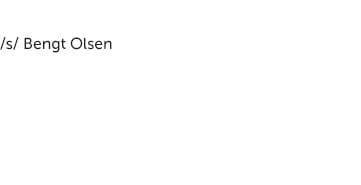

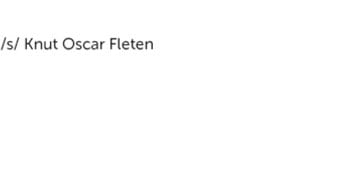

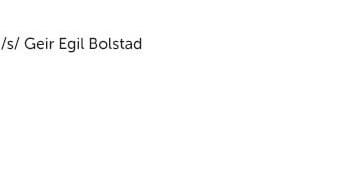
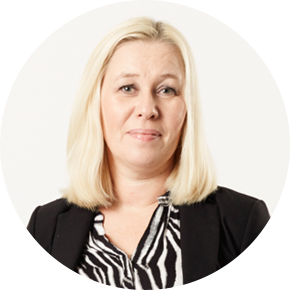
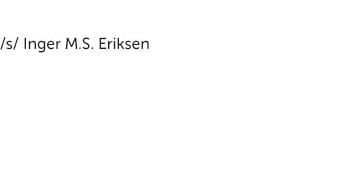

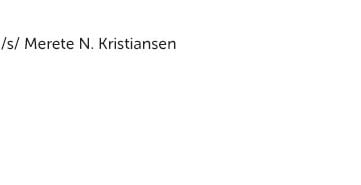

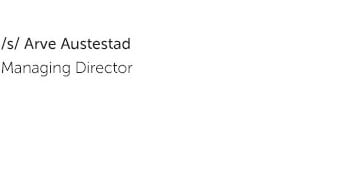
SpareBank 1 Boligkreditt AS
- Statement of the members of the board and the chief executive officer
The Board and the chief executive officer have today reviewed and approved the financial accounts for the first three quarters 2020 for SpareBank 1 Boligkreditt AS. The accounts have been prepared in accordance with the International Financial Reporting Standards (IFRS), as adopted by the EU.
To the best knowledge of the Board and the chief executive officer the accounts have been prepared in accordance with applicable accounting standards and give a true and fair view of the assets, liabilities, financial position and profit or loss of the Company taken as a whole as of 30.09.2020.
The Board of Directors and the chief executive officer declare to the best of their knowledge that the accounts and this Statement gives a true and fair view of the development and performance of the business of the Company, as well as a description of the principal risks and uncertainties facing the Company.
Stavanger, October 21, 2020
The Board of Directors of SpareBank 1 Boligkreditt AS
